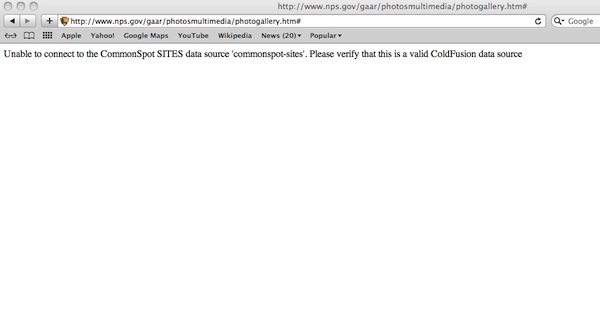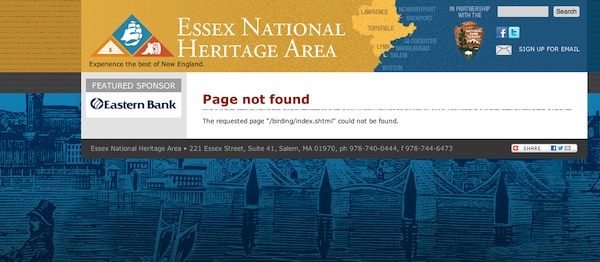
Bummer.
The Internet is the currency of the media world these days, with smartphones, tablets, laptops, and desktops tied into it to get the latest news and information. While the National Park Service is promoting its social media tools, and has greatly improved its websites in recent months, there still are some weak links.
A good example of this need surfaced just the other day, when it was announced that "Tuskegee Institute NHS, Tuskegee Airmen NHS and Selma to Montgomery NHT are extending their reach by using mobile tagging with interactive quick response (QR) codes. Park websites can now be accessed anywhere via mobile devices with a simple scan."
While QR codes provide a quick, easy way to link your smartphone to a specific website, the websites need to be prepared for that traffic. In general, the three sites mentioned above cover the bases in terms of providing visitor information, but there are gaps, and some shortfalls. One disappointing aspect common to not just these three sites but to all NPS sites is the "Schedule of Events" search feature. If a park doesn't populate its calendar, no results are returned. So if you search for events at Selma to Montgomery National Historic Trail between January 5 and the end of March, you'll find there are absolutely no events. Is that truly the case, or hasn't the park staff gotten around to loading that information?
Gettysburg National Military Park's web gurus seem to have realized the frustrating aspect of the event scheduler, and below it places links to upcoming events.
Constant monitoring also is needed to see that a park's "News" section is updated with the most recent release. Visit Selma to Montgomery's website and you'll find that no news releases have been posted since last March 27. Has no other newsworthy item surfaced since then?
Now, there are some very good websites in the National Park System universe. Yellowstone National Park's website overflows with information, so much so that it takes quite a while to digest, and problems arise because it can seem like you're traveling through a maze. If you don't have a well-designed site and an up-to-date Site Map, discovering just what is available for you can be a hit-and-miss proposition.
And sometimes even with a Site Map, 503 errors -- "We're sorry but the page you requested can't be served at this time." -- crop up. Another curiosity about Yellowstone's website (and maybe other nps.gov sites, too) is what happens when you click on the "Website Policies" link. You get a blank page.
But the Yellowstone webmeisters overall do a pretty great job with their pages. Click on the "Plan Your Visit" link on the home page and after a quick, descriptive paragraph of what awaits you in the park they offer a paragraph riddled with hot links to topics such as "things to do," "places to eat," "fees, reservations and permits," "accessibility" and, being seasonally correct, "Visiting in Winter."
Sadly, though, the link to "brochures" was out of operation when I checked Friday. It was back in service Saturday, and the list of available publications was robust, from fire science, bison ecology, and birding reports as well as backcountry planners and historical information. Isle Royale National Park's link to brochures is not as flashy in layout, but still offers a relatively rich selection of topics, from camping and boating to invasive species, fishing regs and the park newspaper.
Most of the big parks -- Yellowstone, Yosemite, Great Smoky Mountains, Grand Canyon, Rocky Mountain -- have content-rich sites that, in general, are easy to explore. Maintenance will take some pages down occasionally -- no doubt the situation with Yellowstone's brochures page -- and that should be expected with the amount of traffic these sites bear.
Still, a general criticism of park websites is they're inconsistent. While some park sites list a page "For Kids" that provides information on Junior Ranger programs, other park sites don't. Some parks view their site's home page as a tourism billboard, and rightly so. Go to Cape Hatteras National Seashore's home page and you'll see links to Directions, Operating Hours & Seasons, Fees and Reservations, Program Schedule, Park Newspaper, and Events, Ocean Swimming Safety, Off-Road Vehicle Use, Climbing the Cape Hatteras Lighthouse and Bodie Island Lighthouse Tours. But there's nothing on camping, a topic that is deeper inside the site, taking three clicks to reach.
Smaller (in size) park units, and large (in size) units that experience relatively little visitation both suffer from a lack of web maintenance, something that could be tied directly to a lack of staff and funding. For instance, if you wanted this past weekend to tour Gates of Arctic National Park and Preserve's photo gallery to go "on a virtual expedition through the vast, expansive, natural beauty of the Brooks Range," you were rewarded with, "Unable to connect to the CommonSpot SITES data source 'commonspot-sites'. Please verify that this is a valid ColdFusion data source."
Curious about the best birding to be found at Essex National Heritage Area in Massachusetts? A bad link takes you to Page not found.

Whoops!
Interested in camping somewhere in the Delaware and Leigh National Heritage Corridor in Pennsylvania? Click on the "Outdoor Activites" link and you're sent to a page that says, "A wide range of lodging and camping opportunities are available within the Corridor, from a gilded age bed and breakfast to primitive camping opportunities." Period. Where you might find those facilities is a mystery.
Some websites can seem a bit mysterious when you reach their homepage. Delaware and Leigh National Heritage Corridor's, for instance, greets you with two links in the left-hand column: Park Home and Plan Your Visit. Click on Park Home and you're taken...to the page you're on. Click on Plan Your Visit and the possibilities open up a bit, with links for directions to the park, operating hours, fees, accessbility, things to do, and things to know before you come...a link that leads to bare bones pages, one on weather that states: We have four seasons and the temperature varies 10 degrees from one end of the Corridor to the other on any given day. The winters are harsher in the two mountainous northern counties (Luzerne and Carbon) than in the southern-most county (Bucks).
No doubt, staffing and funding constraints surely are behind the inconsistencies and shortfalls of nps.gov websites. But here in the 21st century, where information can/should be a click or two away on the Internet, the Park Service needs to not just strive for consistency and delivery, but ensure it.
For starters, it should require that every park's homepage contain links for the basics: Plan Your Visit, Photos & Multimedia, History & Culture, Nature & Science, For Teachers, For Kids, News, and Management. And those pages should have information on them and content that is updated regularly.
If need be, park managers, give your social media staffers a break from Twitter and Instagram and have them spend some time on website content. The rest of us will appreciate it so much more.

 Support Essential Coverage of Essential Places
Support Essential Coverage of Essential Places







Comments
I would like to see some basis park information on every website that goes beyond nature and history.
1. When was the park created? And let's define creation. Either when Congress passed the enabling legislation or when the park actually opened its doors. Very different in most cases.
2. How many visitors came the past year? And keep it up to date.
3. What is the expected recommended length of stay in a park unit? Though it make take you weeks to see Yosemite, that number is very interesting in a historic site or battlefield
4. The size of the park in acres and the number of full-time employees
5. A little on how the park was created.
6. And the most subjective of all. Why was the park unit created? What makes it of national importance?
I can dream, right?
Danny www.hikertohiker.com
Some good concerns, Kurt!
I've experienced frustrations as well, and hope their limited resources allow them to adopt some of your helpful ideas.
However, overall, I really appreciate the design, consistency, and volume of information produced by the NPS. Yes, not all parks have as much info on their sites as they could, but there's an awful lot of great stuff. The Facebook feeds of many of the parks are a daily joy, and by sharing visitors' photos and experiences, [size= 0.95em; line-height: 1.45em]create a sense of community and excitement[/size][size= 0.95em; line-height: 1.45em] that was never possible before. And, the official park map/guides are gorgeous, and great fun to collect (they are my obsession, rather than the passport stamps) -- when I needed to "fill in the blanks" for six of the national parks I had visited but whose guides I was missing, I emailed park staff who promptly responded and mailed me the missing brochures for free. (This was easily done via the websites, with one glitch at Denali that was easily worked around. Folks at Rockies politely asked, "could you please ask us about this later, we're cleaning up from the floods!") [/size]
[size= 0.95em; line-height: 1.45em]With -40 wind chill today in the heart of Indiana Dunes National Lakeshore, I am daydreaming of spring and summer park adventures! [/size][size= 0.95em; line-height: 1.45em]Thanks again for all the good posts here at the NPT website and the Facebook feed. [/size]
I understand any current year's finances are probably in flux, but I think every unit's previous year's appropriations and expeditures should be included online in some detail. I'd also like to see something like an organization chart, even if the names and contact info were redacted.
I can dream, right?
Given the chronic lack of funding and personnel, I think most sites to a remarkably good job. It's not just NPS websites that have occasional shortcomings. I had a dickens of a time yesterday when I tried to gather information about products available at one of our big box stores. And one day last week, my credit union's website was "Down for Maintenance."
About the only frustration I have is that it's very difficult to find out sometimes whether or not a park's campsites are available for reservation. But that's not only the park sites, it's also Recreation.gov and Reserveamerica.com. It's very hard to tell if all available reservations are taken or if that park (or forest or BLM site) is simply not in the system. It would certainly be nice if each park with campgrounds could provide either a link to Recreation.gov or a note telling us that campsites are first come first served.
I think that they need to get away from worrying about how nice and pretty and NPS-uniform the sites are, and have some low-price interns spend time sitting at a non-NPS computer trying to navigate as Timothy Tentpeg, generic citizen would. Simple questions, for a simple and not sophisticated end user. Take a lot of notes, Mr/Ms Intern.
Examples - OK, coming to Jellystone Park, if there is no housing available in the park, what is the nearest campground/motel/BnB that is close enough to still enjoy the park
I'm coming in for thesis resrearch while on vacation - how do contact the park historian or archivist?
Is there a link to local road conditions?
My dog lives in my fifth wheeler with me year around. What should I know?
And other everyday stuff like that.
I know what would make a great drinking game. Every time one of the usual suspects with ties to the NPS says, "chronic lack of funding" or "short staffed", everyone take a drink. Because it makes you want to.
I don't drink.
How about every time you make a post with a negative comment about the NPS you have to give up drinking for a day?
That partially explains why you folks are such whiny stuffed shirts.